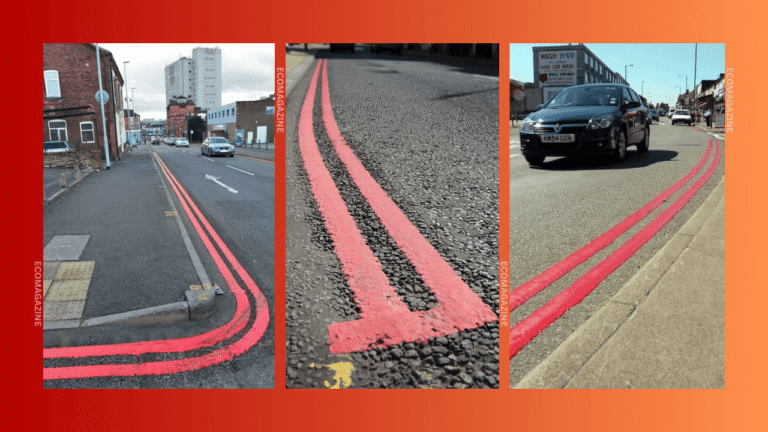Traffic in UK cities can be crowded and tricky to understand. Understanding traffic rules helps everyone travel safely. One important system is called red routes. These are special roads marked with red lines. Understanding a red route helps drivers, cyclists, and walkers stay safe and follow rules in busy UK cities.
This article explains red routes meaning, covers what are red routes, and highlights red routes in major cities like London and others in the UK. It also includes a note on red arrows every day flypast route to clear up any confusion with red routes on roads.
What Is a Red Route?
Definition and Purpose
A red route is a type of road in the UK marked with red lines along the curb or centre. These red lines show strict loading, stopping, or parking controls. The goal is to help traffic flow safely and without delays on busy roads.
There are single red lines or double red lines:
- Single red lines mean limited waiting or loading is not allowed during certain hours.
- Double red lines mean you cannot stop, park, or load there at any time, day or night.
- These rules apply to all drivers unless they have special permission or are emergency vehicles.
Why “Red Route”?
These roads are called “red routes” because of the striking red paint on the road edges. This stands out more than yellow lines, making the restrictions clear and easy to see.
Red Routes Meaning in the UK
Purpose of Red Routes
The red route’s meaning lies in reducing congestion and speeding up traffic in busy areas. Major UK cities use red routes to remove roadblocks like illegal parking or deliveries at peak times. They help improve public transport, emergency services, and general traffic flow.
History and Implementation
London was the first to start using red route in the early 1990s. The city needed a clearer way to manage traffic and loading in busy streets. London’s version grew into a large network. Local councils in other cities like Manchester, Birmingham, and Leeds introduced a few stretches too.
Comparing red route to yellow lines: yellow lines offer some stopping at times or allow loading. Red route are stricter. They often have more enforcement and higher fines.
What Are Red Routes Used For?
Traffic Control and Enforcement
Red routes control traffic by banning stopping, parking, or loading at almost all times. This helps avoid delays caused by vehicles blocking lanes or access points.
Law enforcement uses cameras and patrols to issue fines and pen traffic violations. Broken rules can lead to penalties, often higher than on standard yellow line areas.
Who Can Stop Legally?
Some vehicles are allowed limited stopping:
- Licensed taxis
- Emergency services
- Certain loading vans during permitted hours (on single red lines only)
General drivers must check for signboards indicating allowed times or zones. Stopping to drop or pick up passengers is usually not allowed.
Red Routes in Major Cities
London
London has the largest and most well-known red routes uk network. These cover major roads in central and inner London. These routes link important places such as Heathrow Airport, big train stations, and busy shopping areas. They are looked after by local councils or Transport for London (TfL).
Red Routes Birmingham, Manchester, Leeds, and Others
Other major cities have smaller red route systems:
- Birmingham uses the red route in busy districts around the city centre.
- Manchester has some red route stretches on key arterial roads.
- Leeds uses red lines in dense zones to maintain traffic flow.
Each city maintains signage and rules consistent with the UK’s national design standards.
Recognising Red Routes
Red route have unique markings:
- Bold red lines along the road edge
- Clear signs with hours and rules
- Road name boards may note “red route” to alert drivers
Rules and Penalties on Red Routes
Common Violations
Drivers often break red route rules by:
- Stopping to drop off passengers
- Loading or unloading without a permit
- Double parking or parking in restricted zones
Enforcement Tools
Authorities use automated cameras and roadside patrols. If you break a rule, you may receive a penalty charge notice. These fines are fixed and often higher than standard parking tickets.
Avoiding Penalties
Tips to avoid fines:
- Plan your journey using up‑to‑date maps showing red routes.
- Always read road signs showing permitted hours for single red lines.
- Use legal loading or stopping areas outside red route hours.
- If unsure, do not stop—move to a safe legal area.
Red Routes vs. Other Traffic Schemes
Bus Lanes
Bus lanes are special lanes for buses and sometimes for taxis and cyclists too. You may stop in a bus lane at certain times, but red route never allows stopping at all.
Clearways
Clearways ban stopping during rush hours only, and they may be lifted outside those times. Red routes usually have no stopping at any time (for double lines) or restricted hours (for single lines).
Cycle Lanes
Cycle lanes reserve space for cyclists. They may allow stopping on adjacent lanes. Red routes apply to the whole road edge and are stricter across the board.
Red route are more demanding and have stricter enforcement than these other schemes.
How to Stay Safe on Red Routes
Tips for Drivers
- Learn what a red route is, what it means, and what are red routes in your travel area.
- Use maps or navigation tools that highlight red route in major cities.
- Obey single and double red lines and check permitted times on signs.
- Plan loading or pick‑up outside red route zones or hours.
Helpful Advice for Cyclists and Walkers
- Look out for red route boundaries, especially when crossing roads.
- Avoid waiting or stopping next to red lines.
- Be aware of traffic flow—these roads often have more traffic volume.
Reporting Problems
If you notice faded road lines or broken signs, report them to your local council or road authority. Accurate markings help everyone follow rules correctly.
Red Arrows VE Day Flypast Route (Clarification)
The term red arrows ve day flypast route appears in searches but is not about road systems. It refers to the flight path used by the Royal Air Force Red Arrows aerobatic team during a VE Day celebration. This is an air route, not part of the red route meaning in traffic systems.
This note helps readers who search for that term avoid confusion. Rest assured, red routes and the flypast route are completely separate concepts.
Conclusion
Red routes are vital tools to manage traffic in busy urban areas across the UK. Red routes are busy roads where you cannot stop, park, or load to keep traffic flowing smoothly. Cities such as London, Manchester, Birmingham, and Leeds use them to cut down traffic jams and keep vehicles moving.
When you understand the red route, read signs closely, and plan your trip, you can avoid fines and drive more easily. Clarifying terms like red arrows every day flypast route ensures you know road rules are unrelated to aviation displays. Always check red routes uk maps before travelling in major cities to make your journey clear, safe, and legal.


